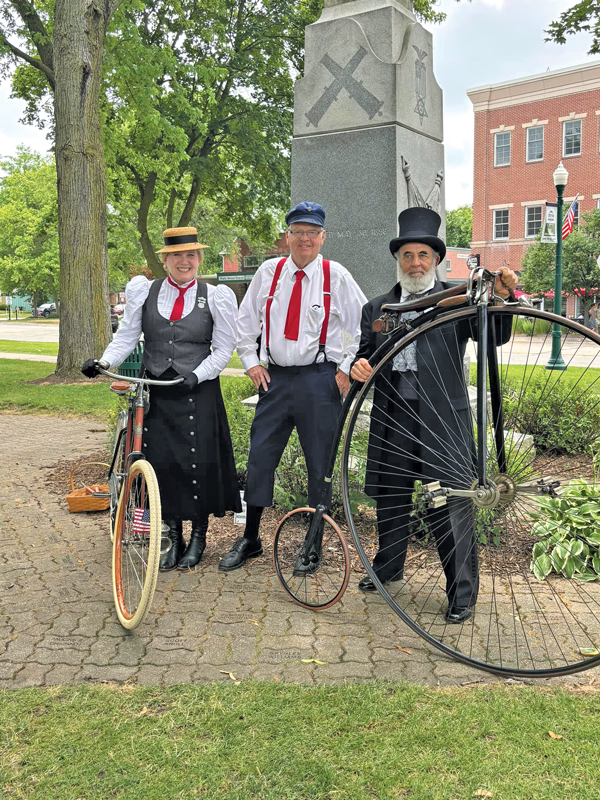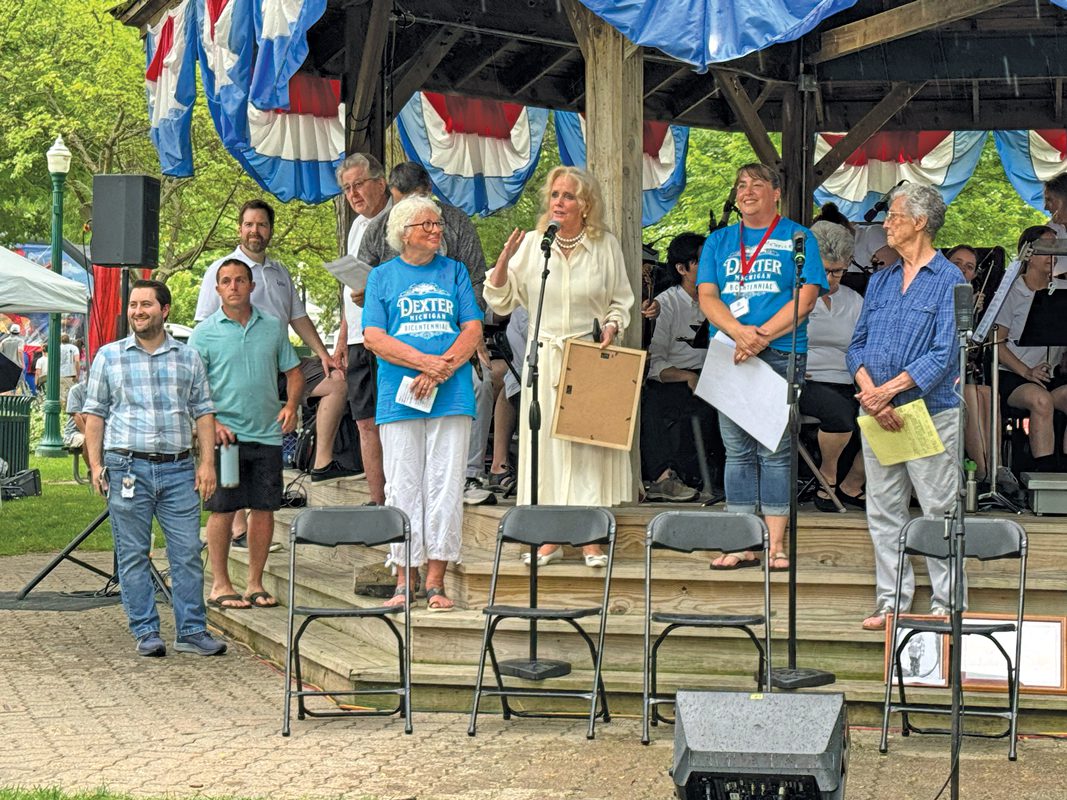
Visiting guests from the Michigan Wheelmen pose with “Samuel Dexter” (Mark Olexa). | Photo courtesy of Michelle Paris
It’s a busy year for Washtenaw County. Ann Arbor, Dexter, and Dixboro all are celebrating their bicentennial birthday in 2024. Two other communities bracket these dates: Ypsilanti marked the 200th anniversary of its first settlement in 2023, while Whitmore Lake’s celebration will be next year.
It’s no coincidence: all were founded during a land rush that followed the defeat of the Midwest’s Indigenous inhabitants and construction of the Erie Canal.
After the Revolutionary War, England ceded its North American claims all the way to the Mississippi River to the United States. In 1787, the Northwest Ordinance decreed that the area north of the Ohio River could be divided into as many as five states. But England had promised its Native allies that it would prevent permanent settlement in the region, and it kept forts in the area until 1794, when an American army defeated a confederation of Native American nations in the Battle of Fallen Timbers in Ohio.
The Americans’ guns and steel swords were a great advantage, but an invisible weapon was even more deadly: the diseases that Europeans had acquired through centuries of trade with Asia and Africa. By the time they arrived in the Americas, most were endemic, circulating constantly but rarely causing mass deaths, because people infected earlier had acquired immunity.
Native Americans had no such protection: their ancestors left Asia before diseases like smallpox and measles made the leap from animals to humans. In the years after European contact, as many as 90 percent of the Indigenous population of the Americas may have died in the “American plagues.”
Weakened by war and illness, representatives of the Potawatomi, Ottawa, Chippewa, and Wyandot (Huron) gave up control of a great swath of Southeastern Michigan in the Treaty of Detroit in 1807. During the War of 1812, a new confederation under the Shawnee leader Tecumseh again allied with the British, but suffered heavy casualties. When Tecumseh died in battle, the alliance collapsed.
Native farmers growing squash, beans, and corn in river bottoms once supported populous communities in southern Michigan. But by the nineteenth century, prolonged cold spells had long since driven the agriculturalists south, replaced by smaller groups that lived mainly by hunting and gathering.
The most numerous were the Potawatomi, whose domain then stretched across Lower Michigan and into Wisconsin. Like those before them, they shaped the landscape in ways that seemed so natural that the first Europeans didn’t even recognize it as a human creation: by setting fire to prairies to preserve the woodland edges that attracted game, they created the “oak openings” that appealed to Ann Arbor’s founders.
Before anyone could buy the land, however, it had to be subdivided. Starting in 1822, surveyor Orange Risdon and his crew laid out six-mile-square townships, each with its grid of planned north-south and east-west roads. Overlaid on Native paths that became Pontiac Trail, Plymouth, Dexter, Geddes, and Liberty roads, and Michigan Ave., his survey still defines the county’s roads.
The U.S. government had “bought” the land for a little more than a penny an acre. In 1824, it offered it for sale at $1.25 an acre, and would-be settlers began scouting out potential farms and town sites. Some arrived by boat via Lake Ontario, Lake Erie, and the Detroit River, braving sudden storms that roiled the shallow lakes. Others made the trek overland, either through Canada or the U.S., traversing rough roads through vast swamps.
The land office in Detroit was their first stop. From there, would-be town builders set out in search of sites on a river or stream that they could dam to power sawmills and grist mills. In Ypsilanti the Huron River runs right through town, while Ann Arbor, Dexter, and Dixboro were all located on its tributaries.

U.S. Rep Dingell joins the celebration in Dexter | Photo courtesy of Quaila Riddle
The first settlers, in 1823, were Benjamin and Ella Woodruff. They’d been living near Sandusky, Ohio, but when Woodruff had inherited money from her grandparents, they decided to invest in Michigan land.
Benjamin took an advance trip accompanied by two neighbors. In Monroe, they met four friends from Sandusky who joined their party. All seven ended up buying land along the Huron. Their settlement, Woodruff’s Grove, was near today’s intersection of S. Grove and S. Prospect streets.
Related: When Water Was Wealth
That winter, Virginian John Allen and Elisha Rumsey, from New York State, met in Detroit and decided to pool their resources. After a February snowfall they took a horse and sleigh to Woodruff’s Grove. Ten miles west, they chose a square-mile town site on what became known as Allen’s Creek. Along with ready water power, the oak openings meant less back-breaking labor to clear forests for farms and houses. The Erie Canal was almost complete, and they expected settlers would soon be pouring in.
Neither man had a good reputation back home. Allen had been given cattle to sell by a group of neighbors, which he did—but instead of returning to give them the proceeds, he used it to buy Michigan land in his own name. Rumsey had been to Detroit before, only to be fetched back to New York State by a lawyer pursuing an unpaid debt.
In the Michigan Territory, they were just two more ambitious speculators. Though their land was not in the center of Washtenaw County, they quickly persuaded the territorial government to make “Annarbour” the county seat. Allen gave land for a courthouse, Rumsey for a jail, and they jointly promised to spend $1,000 to bridge the Huron.
The courthouse at Main and Huron has been replaced twice but remains on its original site. Rumsey’s property on E. Liberty was never used for a jail, but a century and half later ended up in government use after all, as the Federal Building
Allen and Rumsey built a log house on the corner of Huron and First to shelter lot-buyers until they could build their own places. Many years later, an early settler, Harriet Noble, recalled that during her family’s stay, there were just two beds for twenty-one women and fourteen children, so most slept on the floor. “When the children were put in bed, you could not set a foot down, without stepping on a foot or a hand. The consequence [was] we had music most of the time” as people squawked in protest.
A few miles northeast, in Dixboro, former sea captain John Dixboro modeled his own settlement on the towns he’d known in Massachusetts: centered on a town square that housed a church and a one-room school. By 1826, he’d dammed Fleming Creek and built a sawmill and a gristmill.
Samuel Dexter was the wealthiest of the newcomers. Descended from a prominent Massachusetts family, he studied law at Harvard and set up practice in central New York State. But in 1822, his wife and infant daughter died of an unknown illness. He later wrote to a cousin that he “came to Michigan to get rid of the blue devils or to speak more politely of that ennui which like a demon pursues those who have nothing to do.”
Dexter found much to do in Michigan: he rode 2,000 miles on horseback with Orange Risdon before choosing his townsite. First known as the Mill Creek Settlement, it was renamed Dexter in 1830—not for himself, Dexter said, but to honor his father, a U.S. senator and cabinet member.
Dexter remarried before leaving New York, but his second wife, Susan Dunham, died in childbirth in 1827. His third wife, Millicent, who was only sixteen when they married, outlived him for many years.
Dexter’s first house was torn down, but his second, Gordon Hall, remains a commanding presence on top of a hill just outside Dexter in Webster Twp. After some hard years it is now in good hands, with dedicated members of the Dexter Area Historical Society restoring it as they collect funds.
Related: Back to the 1840s
Whitmore Lake was founded by two speculators from Ann Arbor, Jonathan Stratton and Luke Whitmore. Orange Risdon bought the land that would become Saline in 1824, but was too busy surveying to lay out his town until 1829.
Risdon located his own house high on a hill overlooking the road he’d surveyed. He let people bury their dead on his land, and as the cemetery grew, his house was moved to a side street; its original location is marked so visitors can see where it was.

State senator Jeff Irwin, state rep Jason Morgan, and U.S. rep Debbie Dingell with Dixboro United Methodist trustee Kenn Scheffer. | Photo courtesy of Debbie Dingell Facebook
The towns transformed the landscape, but the farmers’ impact was even greater, because they cleared forests and drained swamps to grow crops. The virgin soil was rich, and at first, many settlers prospered. They shopped in the towns and marketed their wheat and apples there, either for local consumption or for shipment to eastern markets after the Michigan Central Railroad came through in the 1830s.
That was when the towns’ fortunes first diverged: Ypsilanti, Ann Arbor, and Dexter were on the main line, but the railroad bypassed Dixboro and Whitmore Lake. Their growth stopped, and neither ever grew large enough to form its own government.
As the soil’s initial fertility was exhausted, many of the first settlers sold out and moved west to start again. The buyers were often immigrants from Swabia in southern Germany, whose frugal ways and regenerative practices sustained them for generations. Other Germans became townspeople, opening everything from breweries to bakeries.
Ann Arbor’s future was decided in 1837, when developers won the University of Michigan by donating the land that became the Diag. Ypsilanti landed the Michigan Normal School, now EMU, in 1849. Both drove their towns’ growth through the twentieth century, but diverged in the twenty-first: The U-M and Ann Arbor have continued to grow, while EMU’s enrollment fell and Ypsi lost population.

Dexter held the biggest celebration: Its June events included a parade and a carnival, with a Ferris wheel towering over Main St. Olexa kept busy posing for photos, including with this group of Girl Scouts. In August, he also appeared at Dixboro’s celebration. | Photo courtesy of Quaila Riddle
As the newcomers arrived in the 1820s, most Potawatomi moved west. At first the migration was voluntary and gradual, but after congress passed a draconian “removal” law in 1830, almost all were forcefully rounded up and exiled to reservations west of the Mississippi.
Today, the Oklahoma-based Citizen Potawatomi Nation counts more than 37,000 registered members in the U.S. and Canada. But there also are four reservations in Michigan, the largest of which is the 1,600-member Nottawaseppi Huron Band of Potawatomi.
Descended from people who escaped removal and bought land south of Battle Creek, they won federal recognition in 1995. In 2009, they opened the monumental Firekeepers Casino in Battle Creek.



